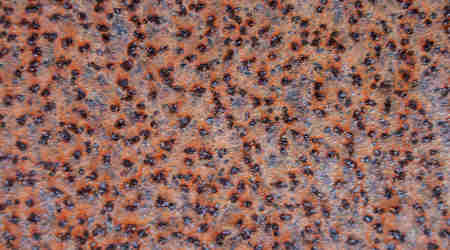« Back to Facilities Management Maintenance & Operations Category Home
Understanding the Danger of Pitting Corrosion
January 12, 2018
- Maintenance & Operations
By Michael Harkin
Pitting corrosion is a localized breakdown of metal manifesting in small cavities or “pits” visible on a metal surface. They’re tiny, and some are nearly invisible, but the damage they cause can be deadly.
Case in point: Pitting corrosion is believed to be the cause of a deadly bridge collapse in 1967. 46 people died when the U.S. Highway 35 bridge between Point Pleasant, WV, and Kanauga, Ohio, fell into the Ohio River.
Investigators determined a small crack formed when one of the bridge’s eyebeams was cast decades before the collapse. The eyebar broke under the compounding stresses of a corrosive environment and newer, heavier vehicles traversing the bridge.
Understanding what pitting corrosion is, how it starts and how to prevent it goes a long way to ensuring long, safe and useful service for metal assets exposed to the elements. Characteristics of pitting corrosion There’s more to the pits indicative of a pitting corrosion attack than meets the eye. Far more damage is done beneath the metal surface because pitting corrosion bores inward. Pitting corrosion causes the loss of metal thickness. That translates to a loss of structural integrity that can lead to stress cracking due to metal fatigue.
For example, if a beam that bears a heavy load loses thickness and mass due to corrosion, there’s less beam available to support the weight. The attack could go unnoticed but, over time, the fatigue this causes could lead to the formation of cracks. Cracks can quickly lead to a failure of the beam, which could set off a catastrophic chain reaction as unplanned stresses multiply. How does pitting corrosion start?
There are several potential causes for pitting corrosion, including the following:
- Localized mechanical or chemical damage to a metal’s protective oxide film.
- Improper application of corrosion control products.
- The presence of non-metal materials on the surface of a metal.
When metals that aren’t properly treated are freely exposed to the elements, chemical reactions between metals and the environment form compounds like ferrous oxide, more commonly known as rust.
Preventing pitting corrosion
Preventing pitting corrosion starts early. First and foremost, choosing the right metal during the design of an asset makes a big difference. The risk of pitting corrosion is greatly reduced when you know ahead of time how materials react in different environments. Higher-alloy metals resist corrosion more strongly than do low-alloy materials.
Next, control the environment to the extent it’s possible. For indoor or sheltered assets, keeping environmental factors like temperature, pH and chloride concentration in check minimizes the risk of pitting corrosion, ensuring a long useful life for your assets.
Finally, apply the proper industrial coating to your assets and have them inspected regularly by trained corrosion control experts. They use modern non-destructive testing (NDT) methods to survey the condition of metal assets without causing needless damage.
Michael Harkin is a NACE and SSPC coating inspector and current President of FeO – a QP5- certified coating inspection and consulting company. Prior to FeO, Michael served as an Army soldier and a Marine Corps officer. To learn more about FeO, go to www.FeOinc.com.








